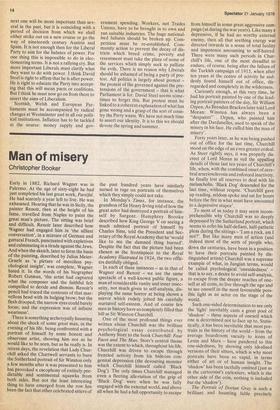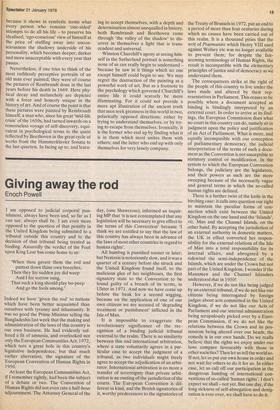Man of misery
Christopher Booker
Early in 1882, Richard Wagner was in Palermo. At the age of sixty-eight he had just completed his last great work, Parsifal. He had scarcely a year left to live. He was exhausted. Hearing that he was in Sicily, the painter Renoir, then at the height of his fame, travelled from Naples to paint the great man's picture. The sitting was brief and difficult. Renoir later described how Wagner had engaged him in 'the silliest conversation', in a mixture of German and guttural French, punctuated with expletives and culminating in a tirade against the Jews. And when the sketch, later to form the basis of the painting, described by Julius MeierGraefe as 'a picture of merciless psychological insight', was complete, Wagner hated it. In the words of his biographer Robert Gutman, 'the artist had captured what the composer and the faithful felt compelled to deride and dismiss. Renoir's pencil had traced the contours of that marvellous head with its bulging brow; but the flesh drooped; the narrow eyes could barely focus; and the expression was of infinite weariness'.
There is something archetypally haunting about the shock of some great man, in the evening of his life, being confronted with a portrait of himself by some honest and observant artist, showing him not as he would like to be seen, but as he really is. In recent days, the revelation that Lady Churchill asked the Chartwell servants to burn the Sutherland portrait of Sir Winston only a few months after it was presented to him has provoked a cacophony of entirely predictable and sentimental squawks from both sides. But not the least interesting thing to have emerged from the row has been the fact that other celebrated sitters of the past hundred years have similarly turned in rage on portraits of themselves which they simply could not take.
In Monday's Times, for instance, the grandson of Sir Henry Irving told of how the great actor had destroyed a portrait of himself by Sargent. Humphrey Brooke described how King George V on seeing a much admired portrait of himself by Charles Sims, told the President and Secretary of the Royal Academy that he 'would like to see the damned thing burned'. Despite the fact that the picture had been chosen as the frontispiece to the Royal Academy Illustrated in 1924, the two officers dutifully obliged.
In each of these instances — as in that of Wagner and Renoir — we see the same spectacle of a well-known public figure, a man of considerable vanity and inner insecurity, not much given to self-analysis, displaying the same horror at being shown a mirror which rudely jolted his carefully nurtured self-esteem. And of course few men in history have so completely filled that bill as Sir Winston Churchill.
One of the most profound things ever written about Churchill was the brilliant psychological essay contributed by Anthony Storr to the book Churchill: Four Faces and The Man. Storr's central theme was the extent to which, throughout his life, Churchill was driven to escape through frenzied activity from his hideous congenital depression (the devouring monster which Churchill himself called 'Black Dog'). The only times Churchill managed even a fleeting alleviation of the grip of 'Black Dog' were when he was fully engaged with the external world, and above all when he had a full opportunity to escape from himself in some great aggressive campaign (at during the war years). Like many a depressive, if he had no worthy external enemy, then all that seething energy was directed inwards in a sense of total futility and impotence amounting to self-hatred. There were many such periods in Churchill's life, one of the most dreadful to endure, of course, being after the failure of the Turkish campaign of 1915, when after ten years at the centre of activity he suddenly found himself out of office, disregarded and completely in the wilderness.
Curiously enough, at this very time, he had his portrait painted by one of the leading portrait painters of the day, Sir William Orpen. As Brendan Bracken later told Lord Moran: Winston has always been a "despairer" Orpen, who painted him after the Dardanelles, used to speak of the misery in his face. He called him the man of misery'.
Forty years later, as he was being pushed out of office for the last time, Churchill stood on the edge of an even greater ordeal. As Storr rightly says, it was properly discreet of Lord Moran to veil the appalling details of those last ten years of Churchill's life, when, with the combined onset of cerebral arteriosclerosis and enforced inactivity, he finally lost all reserves to deal with his melancholia. 'Black Dog' descended for the last time, without respite. 'Churchill gave up reading, seldom spoke and sat for hours before the fire in what must have amounted to a depressive stupor'.
To most of us today it may seem incomprehensible why Churchill was so deeply depressed by the Sutherland portrait, which seems to echo his half-defiant, half-pathetic pleas during the sittings — 'I am a rock, am I not?'. But like many men of action (and indeed most of the sorts of people who, down the centuries, have been in a position to have their portraits painted by distinguished artists) Churchill was a supreme example of what, in Jungian terms, would be called psychological 'onesidedness' — that is to say, a desire to avoid self-analysis, to escape from the deeper reaches of oneself at all costs, to live through the ego and to see oneself in the most favourable possible light as an actor on the stage of the world.
Such one-sided determination to see only the 'light' inevitably casts a great pool of 'shadow' — these aspects of oneself which one is determined not to face up to. Statistically, it has been inevitable that most portraits in the history of the world — from the average boardroom vacuity to icons of Lenin and Marx — have pandered to this one-sidedness, by showing only idealised versions of their sitters, which is why most portraits have been so vapid, in terms either of art or of human insight. The 'shadow' has been tactfully omitted (just as in the cartoonist's caricature, which is the other side of the coin, nothing is included but the `shadow').
The Portrait of Dorian Gray is such a brilliant and haunting fable precisely because it shows in symbolic terms what every person who remains 'one-sided' attempts to do all his life — to preserve his idealised, 'ego-conscious' view of himself at the price of stuffing away into unconsciousness the shadowy underside of his personality, which becomes deeper, darker and more unacceptable with every year that passes.
Nevertheless, if one tries to think of the most ruthlessly perceptive portraits of an old man ever painted, they were of course the pictures of Rembrandt done in the last years before his death in 1669. Here physical decay and melancholy are depicted with a force and honesty unique in the history of art. And of course the point is that these pictures were painted by Rembrandt himself, a man who, since his great 'mid-life crisis' of the 1650s, had turned inwards on a remorseless voyage of self-discovery, equivalent in psychological terms to the quest reflected by Beethoven in the great cycle ol works from the Hammerklavier Sonata to the last quartets. In facing up to, and learn ing to accept themselves, with a depth and determination almost unequalled in history, both Rembrandt and Beethoven came through 'the valley of the shadow' to discover in themselves a light that is transcendent and universal.
Winston Churchill's agony at seeing himself in the Sutherland portrait is something none of us can really begin to understand — because he saw in it things which no one except himself could begin to see. We may regret the destruction of the painting as a powerful work of art. But as a footnote to the psychology which governed Churchill's entire life it could scarcely be more illuminating. For it could not provide a more apt illustration of the ancient truth that men seek greatness in this world in two, polarically opposed directions: either by trying to understand themselves, or by trying to escape from themselves. Ironically, it is the former who end up by finding what it is in them which most unites them with others; and the latter who end up with only themselves for very lonely company.



































 Previous page
Previous page